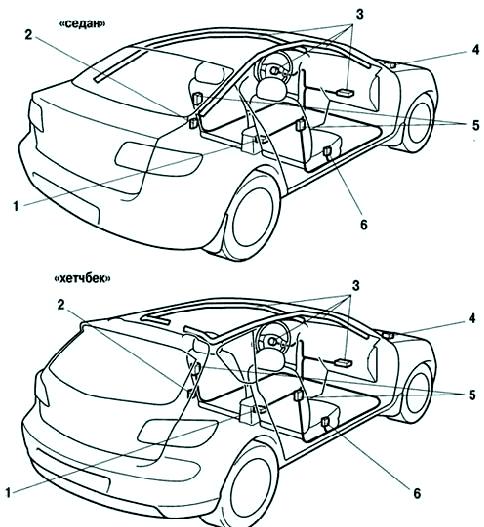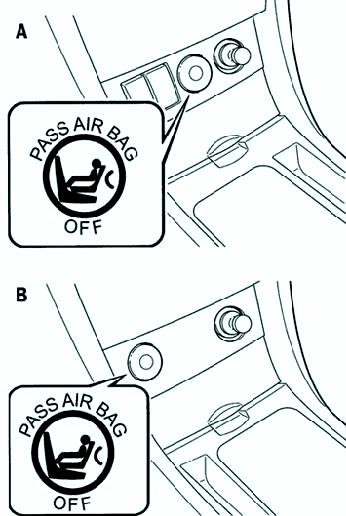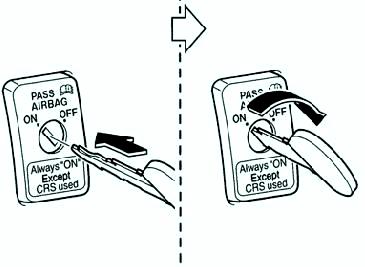The Supplementary Restraint System (SRS) includes two main subsystems:
- - airbag system with gas generators;
- - an electrical system with shock sensors and a fault diagnostics module.

Inflatable bags are installed on the car in the following places: the steering wheel hub, the front panel (on the right side), the backs of the front seats (on the side of the doors), the front and rear pillars of the body, and also along the edge of the ceiling above the openings of the side doors.
Airbags and inflatable curtains are installed discreetly and are not visible until they are deployed (Fig. 1).
Front and side airbag systems include up to 6 inflatable elements (the location of the airbags in the car is indicated by the SRS AIRBAG marking).
Additional passive safety systems operate independently of each other.
If your vehicle is equipped with side airbags and curtain airbags, they will generally not deploy on both sides of the vehicle in the same crash, as the vehicle is not often hit from both sides at the same time.
Normally, the side airbags and curtain airbags do not deploy at the same time as the frontal airbags in the same accident.
The exception is traffic accidents in which the car is subjected to both frontal and side impacts.
Inflatable airbag systems are designed only to provide additional passive protection for the driver and front passenger (in certain types of vehicle collisions), as well as passengers sitting in the outer seats in the rear seat (only in side impacts of the vehicle).
Therefore, the driver and all passengers must always fasten their seat belts while driving.
If you do not fasten your seat belt, the airbags will not provide effective protection in the event of an accident.
A fastened seat belt provides the following:
- - keeps the driver or passenger from a sharp throw forward into an inflating airbag;
- - Reduces the chance of injury in crashes where airbags are not designed to deploy, such as rollovers and rear-end collisions;
- - reduces the likelihood of injury in frontal and side collisions of the car, the force of which is insufficient to deploy the airbags;
- – reduces the chance of falling out of the car;
- - reduces the chance of injury to the lower body and legs in a traffic accident (airbags are not designed to protect these parts of the body);
- – keeps the driver in a position that allows better control of the vehicle.
If the child's height does not allow the use of a seat belt, it is necessary to seat and secure the child in a child restraint.
Choose the child restraint that fits your child carefully.
Follow the instructions in this book and the child restraint manufacturer's instructions for installation.
Front passenger airbag switch

The vehicle is equipped with a front passenger airbag deactivation switch.
The location of this switch is shown in Figure 2.
The switch allows you to deactivate the front passenger's front and side airbags, as well as the pyrotechnic pretensioner of the respective seat belt.
This feature is provided for when a child restraint is installed on the front passenger seat.

The front passenger airbag deactivation switch allows you to deactivate the front passenger's front and side airbags, as well as the corresponding seat belt pretensioner.
Make sure the switch for these airbags is in the "ON" position, unless a child restraint is installed in the front passenger seat.
When the ignition switch is turned to the "ON" position (ignition on), the front passenger's airbag deactivation indicator will illuminate for approximately 6 seconds (fig. 3).
In any of the following cases, you should have an authorized dealer check the passenger airbag deactivator.
- - The airbag deactivation indicator does not come on when the ignition switch is turned to the "ON" (ignition on) position.
- - The airbag deactivation indicator does not illuminate when the ignition is on and the front passenger airbag switch is set to the OFF position.
- - The airbag deactivation indicator stays on when the ignition is turned on and the front passenger airbag switch is set to the ON position.
Front passenger airbag deactivation
Always check that the front passenger airbag switch is in the correct position before driving.
WARNING Do not leave the key in the front passenger's airbag switch. Unintentional deactivation of these airbags is dangerous.
In the event of an accident, the passive protection of the front passenger will not be adequate.
This is fraught with serious injuries and even death of the passenger.
Always use the same key to operate the switch and the ignition switch to prevent unintentional deactivation of the front passenger airbags.
In this case, you will never leave the key in the airbag switch.

- 1. Insert the key into the slot on the front passenger's airbag switch and turn it clockwise to the "OFF" position (fig. 4).
- 2. Remove the key from the switch.
- 3. Check that the front passenger's airbag deactivation indicator is on when the ignition is on.
The passenger's front and side airbags and the corresponding seat belt pretensioner remain in the off position until the switch is turned back to the ON position.











